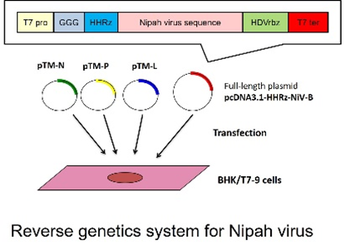-
Faculty of Veterinary Medicine, Department of Veterinary Medicine
- Associate professor
- Kei-ichi KATAYAMA
- Research Field
Laboratory animal science, Neroscience
- Keyword(s)
Neuropsychiatric disorder, Model animal, Neural development
- Research theme
-
- Pathogenesis of neurological and psychiatric disorders
- Mechanism of neural network formation
- Generation of animal models of disease
Outline of research activities

For neruvous system to function properly, each component cell must be produced in adequate numbers, placed in the correct position, and correctly networked with each other. Any failure in any of these processes can impair neurological function and cause neurological and psychiatric disorders. Through the generation and analysis of animal models of neurological and psychiatric disorders, I am working to elucidate the pathogenesis of these diseases and to understand the fundamental mechanisms underlying the development of neural tissue, especially the process of neural network formation.
- Desired cooperation
-
- Pathogenesis of neurological and psychiatric disorders
- Generation and analysis of animal models of disease
-
Faculty of Veterinary Medicine, Department of Veterinary Medicine
- Associate professor
- Keiichi HISAEDA
- Research Field
Livestock Hygiene, Clinical Veterinary Medicine for Production Animals
- Keyword(s)
Mastitis, Milk squeezing hygiene, Livestock feeding management, Infectious diseases
- Research theme
-
- Research on pathogenesis and control of mastitis in dairy cows
- Research on productivity improvement in livestock production
- Research on the Role of Livestock Production in Climate Change and its Contribution to Society
- Research on the improvement of medical treatment techniques in clinical practice for industrial animals. etc.
Outline of research activities

Mastitis is the most devastating economic burden in dairy farms. We have studied the epidemiology of acute mastitis caused by coliforms, the relationship between clinical symptoms and cytokines and acute phase proteins, and the relationship between symptoms and prognosis, and found a link. In addition, in the treatment of mastitis, it was found that the application of a lotion with antibacterial activity (Ceramella) to the inflamed udder, in addition to conventional antibiotic treatment, decreases breast induration and somatic cell count. Studies have shown that the shorter the milk is cultured, the more causative organisms are detected in bacteriological tests of milk. As for prevention of mastitis, administration of a leptospirosis vaccine has been shown to reduce clinical forms of mastitis. It was also found that the severity of symptoms of acute mastitis caused by Escherichia coli was related to the level of ionized calcium in the blood at the time of initial examination. We are studying prevention, treatment, and prognosis of mastitis in dairy cows. It was found that there is a relationship between blood physiological changes in dairy cows in response to climatic changes and stress. Based on the results of this research, we would like to further our research on improving milk productivity.
- Desired cooperation
-
- Research and drug development for prevention and treatment of mastitis
- Research on Biocides and Improvement of Livestock Productivity
- Research on Climate Change and Animal Welfare in Industrial Animals
- Research on infectious disease control in production animals. etc.
-
Faculty of Veterinary Medicine, Department of Veterinary Medicine
- Associate professor
- Michihito TAGAWA
- Research Field
Oncology, Internal Medicine, Clinical Pathology, Immunology
- Keyword(s)
Dog, Cat, Liquid biopsy, Cytology, Anticancer drug exposure
- Research theme
-
- Development of novel tumor diagnostic markers for dogs and cats
- Establishment of liquid biopsy in veterinary medicine
- Anticancer drug exposure risk survey in animal hospitals
Outline of research activities
Due to improvements in breeding methods and advances in veterinary medicine, the average lifespan of pets has increased dramatically. Unlike humans, animals often do not show their illness even when they are sick, and by the time they notice it, it often progresses and is difficult to treat. Advanced diagnostic imaging such as CT and MRI and various “cancer markers” are used in human medicine, but there are no “cancer markers” that can be used in veterinary medicine, and advanced diagnostic imaging requires high cost and general anesthesia. If there is a disease marker that accurately reflects the pathology of “cancer”, it will be possible for owners and patient animals to avoid the burden of anesthesia and examination, and to objectively judge the need for continuous treatment. Therefore, in recent years, we have focused on a technology called liquid biopsy, which has been attracting attention in medicine, to detect genes circulating in the blood, and we are researching its application to pet cancer. Specifically, we are investigating the usefulness of tumor pathological evaluation and diagnostic markers by measuring the amount of genes released from the tumor itself and detecting specific mutations.

- Desired cooperation
-
- Research on genetic analysis and bioinformatics
- Research on artificial intelligence and deep learning for tumor diagnosis
- Research on cancer and palliative care in veterinary medicine
-
Faculty of Veterinary Medicine, Department of Veterinary Medicine
- Associate professor
- Sachiko CHIKAHISA
- Research Field
Sleep Physiology, Behavioral Science
- Keyword(s)
Sleep, Energy Metabolism, Behavior, Stress
- Research theme
-
- Sleep and Energy Metabolism
- Sleep Loss and Behavioral Changes
- Stress and Sleep Homeostasis
Outline of research activities
Japanese people sleep less than most developed countries, and one out of every four to five adults has some kind of sleep problem. Sleep deprivation is known to increase the risk of developing depression, anxiety disorders, obesity, and diabetes. My research aims to elucidate the molecular mechanisms underlying these effects of sleep deprivation on the body and mind. In addition, by studying the effects of physical, chemical, psychological, and social stress on sleep homeostasis using mouse models, I aim to elucidate the molecular mechanisms underlying stress-induced sleep disorders and psychiatric disorders and to contribute to the development of preventive and therapeutic methods.
- Desired cooperation
-
- Researches on energy metabolism
- Researches on biological responses to various stresses
- General research on brain functions
-
Faculty of Veterinary Medicine, Department of Veterinary Medicine
- Associate professor
- Shumpei WATANABE
- Research Field
Virology, Immunology, Evolutionary Biology
- Keyword(s)
Paramyxovirus, Bat, Fusion, Biosafety Level 4, Quasispecies
- Research theme
-
- Study of highly pathogenic zoonotic viral diseases
- Mechanism of paramyxovirus infection in the CNS
- Development of attenuated vaccine using codon optimization technique
Outline of research activities
We aim to reveal the mechanism of pathogenicity on highly pathogenic viral zoonoses, using our Biosafety level 3 (BSL3) laboratory, as well as BSL4 facility in the foreign country (as a coolaborative research with Australian Animal Health laboratory, CSIRO).
So far, through a collaborative research with AAHL, we had established the reverse genetics system for nipah virus or hendra virus. By introducing mutations into the viral genome with the system, we are trying to rescue or make mutant virus and characterize the mutant virus. This approach would find or characterize nature of the original virus. Moreover, we would like to develope effective and safe vaccines for the viruses using recombinant mutant viruses.

- Desired cooperation
-
- Pathological researches
- Development of anti-viral drugs using bioinfomatics and synthetic chemistry
- Epidemiological researches on wild animals
-
Faculty of Veterinary Medicine, Department of Veterinary Medicine
- Associate professor
- Tsunehito HIGASHI
- Research Field
Toxicology, Molecular Pharmacology
- Keyword(s)
Cell Death, Cytotoxicity, Cigarette Smoke, Oxidative Stress
- Research theme
-
- Mechanisms for cytotoxicity of chemical compounds
- Effects of cigarette smoke on cellular activities
- Relationship between oxidative stress and cell physiology
Outline of research activities


There are many types of chemical compounds in our environment, and some of them have negative effects on our bodies. Cigarette smoking is a risk factor for various diseases such as atherosclerosis, hypertention, COPD, and cancer. However, there are no clear information which chemical compounds in the cigarette smoke have negative effects on our bodies and cause these diseases. I have previously identified unsaturated carbonyl compounds as stable cytotoxic factors in the gas phase of cigarette smoke. The unsaturated carbonyl compounds are also contained in the smoke from combustion of organic materials such as woods, oil, coal. Thus, the unsaturated carbonyl compounds are regarded as environmental pollutants. The purpose of my study is elucidation of the molecular mechanisms for cytotoxicity of environmental pollutants including unsaturated carbonyl compounds.
- Desired cooperation
-
- Pathologycal analyses
- In vivo analyses
- Comprehensive analyses
-
Faculty of Veterinary Medicine, Department of Veterinary Medicine
- Associate professor
- Tsuneyuki MASUDA
- Research Field
Animal health and hygiene
- Keyword(s)
Livestock chronic infection, Bovine viral diarrhea, Enzootic bovine leukosis
- Research theme
-
- Effect of chronic infection on productivity
- Establish a model to prevent the spread of BLV and BVD
- Study of insect pest-control using natural maerials
Outline of research activities

Infectious livestock diseases, such as highly pathogenic avian influenza recognized as acute infection that cause tremendous damage to the livestock industry. Acute infections develop relatively early and have significant clinical symptoms, making outbreaks easily recognizable. Conversely, chronic infections that decrease livestock productivity, such as enzootic bovine leukosis (BLV) and bovine viral diarrhea (BVD), have become problematic in recent years. Generally, eradication of chronic infections is extremely difficult and requires considerable time and effort.
I want to study the Effect of these diseases on the livestock industry using field cases, and want to research the viable approach of preventing the spread of BLV and BVD. I also study environmentally friendly insect pest-control using natural materials, such as commercially available diatomite product.- Desired cooperation
-
- Veterinary epidemiology
- Virology
- Theriogenlogy
-
Faculty of Veterinary Medicine, Department of Veterinary Medicine
- Lecturer
- Hikaru FUJII
- Research Field
Virology
- Keyword(s)
infectious disease, virus, recombination, host specificity, epidemiology
- Research theme
-
- Mechanism determining the host specificity of herpesvirus.
- Analysis of virus-host interaction
- Analysis of pathogenicity of SFTS virus.
- Epidemiological studies of herpesvirus.
Outline of research activities

More than 200 herpesviruses have been discovered and most of them have very limited host range. Therefore, there are many herpesviruses which have not established cell culture system to replicate or system to evaluate the pathogenicity of the virus using experimental animals. Without these systems it is impossible to analyze the precise mechanism of viral replication and pathogenicity. Thus, I aim to unveil the determination mechanism of host specificity of herpesvirus by analyzing the interactions of virus and host factors by using recombinant viruses. In addition, I also study epidemiology of herpesviruses.
As SFTS virus seems to be spread in Ehime, our lab focuses on SFTS virus. I compare the pathogenicity of SFTS virus and its related virus, Heartland virus and analyze which factor causes the difference.
- Desired cooperation
-
- Pathology
- Statistics
- Ecology
- Proteome analysis
-
Faculty of Veterinary Medicine, Department of Veterinary Medicine
- Lecturer
- Jiro MIYAMAE
- Research Field
Comparative immunology, Comparative genetics, Transplantation immunology
- Keyword(s)
Major histocompatibility complex (MHC), Transplantation, autoimmune disease
- Research theme
-
- Polymorphism and functional analysis of MHC about animals
- Elucidation of correlation between MHC and diseases such as graft rejection and autoimmune diseases
- Assesment for genomic diversity about animals based on MHC genes
Outline of research activities
Major histocompatibility complex (MHC) molecule is a glycoprotein expressed on cell surface. MHC molecule plays important role for inducing acquired immunity by presenting self or non-self peptides to T cells. it is known that MHC genes encoding MHC molecules are highly polymorphic genes. In human, various report shows these polymorphisms are related with the risk for graft rejection, tumor and development of autoimmune diseases. However, the correlation between MHC polymorphisms and various diseases in small animals such as dog and cat were unclear so far.
I study about the polymorphisms and functions of MHC in animals and relation of MHC with various diseases. Through these studies, I want to incarnate the regenerated medicine with stem cell transplantation in veterinary medicine and the elucidation for mechanisms of development of autoimmune diseases.- Desired cooperation
-
- Regenerated medicine with stem cell transplantation
- Elucidation for mecahisms and pathology of autoimmune disease
- Study about evolution and origin of canine and feline species
-
Faculty of Veterinary Medicine, Department of Veterinary Medicine
- Lecturer
- Kei HAYASHI
- Research Field
Parasitology, Veterinary Parasitology, Phylogeny
- Keyword(s)
Parasite, Trematode, Cestode, Nematode, Helminth
- Research theme
-
- Relationship between the parasite evolution and their host.
- Parasite dynamics, pathogenesis and morphological and molecular characters.
- More usuful diagnosis and identification methods for parasites.
Outline of research activities





I analyze influences of biogeographic phenomena such as evolution and migration of host animals on parasite distribution or population using molecular phylogenetic analyses. I’m also conducting research on the mechanisms of migration and pathology of helminths in their host.

- Desired cooperation
-
- Experimental biological research of parasitic helminths.
- Biogeographic study of host livestocks and wild animals.
-
Faculty of Veterinary Medicine, Department of Veterinary Medicine
- Lecturer
- Kohei MURAKAMI
- Research Field
Immunology, Bone metabolism,
- Keyword(s)
Polyarthritis, WNT signaling
- Research theme
-
- Pathogenesis of canine idiopathic immune-mediated polyarthritis
- Roles of WNT signaling on bone metabolisms
Outline of research activities
Rheumatoid arthritis (RA) is a disease based on chronic inflammation in synovium. Since RA is a relatively common disease in human, there are many studies on its pathogenesis, and recently we can control RA with biological drugs or small molecular compounds. Dogs may develop a disease similar to that of human, also known as canine rheumatoid arthritis (cRA). However, since there are few studies on its pathophysiology, most dogs with cRA take only symptomatic treatment, and joint structures are irrevocably destroyed. I am studying to elucidate the inducer of inflammation in cRA, identification of early diagnostic marker, and development of new therapeutic drug.
I am also studying the Wnt5a antagonist Sfrp5. Sfrp5 is an adipokine that regulates the metabolism of adipocytes. We already found that Sfrp5 regulates not only adipocytes but also osteoblasts and osteoclasts. In other words, fat tissue may control bone. I am studying the mechanisms how Sfrp5 regulates bone.- Desired cooperation
-
- Study of rheumatoid arthritis
- Development of new drugs
-
Faculty of Veterinary Medicine, Department of Veterinary Medicine
- Lecturer
- Kosuke TAKEYA
- Research Field
Biochemistry, Physiology
- Keyword(s)
Smooth Muscle, Cell Signaling
- Research theme
-
- Regulatory mechanisms of smooth muscle contraction and relaxation
- Regulatory mechanisms of renal microcirculation
- Development of highly sensitive phosphorylation analysis
Outline of research activities
Smooth muscle composes a muscular layer in various organs, such as blood vessels, gastrointestinal tracts, bladder, uterus, etc. in the vertablate body. It plays important roles in many life stages from birth to death. To achieve different roles in different locations, each smooth muscle has unique regulatory mechanisms of contraction and relaxation. For example, renal arteriolar smooth muscle, which regulates blood flow in the kidney, contracts in response to a vasoconstrictor, angiotensin II by activating molecular motor in the cells. On the other hand, another vasoconstrictor, endothelin 1, induces abnormal contraction in the arteriole by excessively activating the motor. I hve been studying the molecular mechanisms of smooth muscle contractions, especilly in the renal arterioles.

- Desired cooperation
-
-
Faculty of Veterinary Medicine, Department of Veterinary Medicine
- Lecturer
- Masashi MUKOHDA
- Research Field
Pharmacology, Molecular biology, Vascular biology
- Keyword(s)
Circulation, Hypertension, Arterial Stiffness, Microbiome
- Research theme
-
- Exploring outbreak and molecular mechanisms of hypertension
- Exploring mechanism of arterial stiffness
- Research on microbiome and inflammatory disorder
Outline of research activities
To explore my interest using a molecular biology approach, we employ novel transgenic animal models and ex vivo or in vitro systems such as isolated vessel and cell culture.
Cardiovascular disease is a major cause of mortality. In particular, the prevalence of hypertension is high and increasing (American Heart Association). To understand the mechanism of outbreak and molecular alterations in hypertension, we examine how genes regulate organ function related to regulating blood pressure including vessel, heart, kidney and brain using transgenic model.
Gut microbiome research is becoming the key to better understanding physiology and pathology. Clinical evidence is accumulating for a role of the microbiome in contributing to aging and inflammtory disorder. We try to find how microbiome affects body.- Desired cooperation
-
- Drug development
- Cardiovascular disease research
- Gut microbiome research
-
Faculty of Veterinary Medicine, Department of Veterinary Medicine
- Lecturer
- Shin-ichi NAKAMURA
- Research Field
Veterinary Pathology, Toxicologic Pathology, Zoo and Wildlife Medicine, Veterinary Forensic Medicine
- Keyword(s)
Diagnostic Pathology, Experimental Pathology, Veterinary Forensic Medicine, Investigation of the cause of the death
- Research theme
-
- Pathological analysis of spontaneous diseases in various animals
- Pathological evaluation of studies using various animal models of disease
- Investigation of the cause of the death in animals
Outline of research activities



Veterinary pathology is the study of the causes of animal diseases and the study of their mechanisms. The results revealed by veterinary pathology are returned to clinical practice to help diagnose and treat animal diseases. Although our research targets all kinds of animals other than humans, we also contribute to the human medicine through basic research using laboratory animals.
I have experience in pathological diagnosis in a variety of animals, including companion animals, industrial animals, laboratory animals, wild animals, exotic animals, zoo and aquarium animals, fish, and invertebrates. I aim to identify issues from spontaneous diseases seen in various animals and to conduct research that can be fed back to clinical practice. At the same time, I will develop basic research using experimental pathological methods.- Desired cooperation
-
- Investigation of the cause of the death in animals
- Research on elucidating the mechanisms of various animal diseases.
- Studies on the isolation and identification of pathogens and the analysis of trace elements.
-
Faculty of Veterinary Medicine, Department of Veterinary Medicine
- Lecturer
- Shuichi CHIBA
- Research Field
Neuroendocrinology, Psychopharmacology
- Keyword(s)
Stress (psychological), Neuroprotection, Sex steroids, Animal model of psychiatric diseases
- Research theme
-
- Pathophysiology of the depression caused by chronic stress exposure
- Neuroprotective effect of sex steroid hormones
Outline of research activities


Chronic exposure to psychological stress leads to increased levels of hormones and cytokines, including glucocorticoids, in the blood or brain tissue. These substances may be involved in the pathogenesis of psychiatric disorders such as depression. To study the chronic effects of glucocorticoids on the nervous system, we are creating animal models of depression to identify useful targets for the treatment of depression. Steroid hormones are also known to protect nerve cells (neuroprotection) and I am investigating how this action is altered in the pathogenesis of depression and whether it can be used to develop treatments.
- Desired cooperation
-
- Research about neuroendocrinological diseases
- Development of animal models of psychiatric disease and exploratory research using the models
- Research about neuroprotective effect of sex steroid hormone
-
Faculty of Veterinary Medicine, Department of Veterinary Medicine
- Lecturer
- Takamasa ITOI
- Research Field
Neurology, Rregenerative Medeicine
- Keyword(s)
Spinal Cord Injury, Spinal Cord Regeneration, Rehabilitation, Ggait Aanalysis
- Research theme
-
- Developing new treatment for Spinal Cord Injury
- Study of Spinal Cord Injury Markers
- Dog gait analysis
Outline of research activities
Regenerative medicine is attracting as much attention in the veterinary medicine field as in the human medicine field. Research in the veterinary medicine is also expected to be returned to the human medicine. Severe spinal cord injuries in small animal clinical practice often result in animals that cannot walk or stand on their own even after treatment, and there is a need to develop new treatment for spinal cord injuries. In this laboratory, we are conducting research on the development of spinal cord regeneration therapies using stem cells that can be isolated from living tissue and various cytokines. We are also researching the effectiveness and efficacy of rehabilitation as well as the development of new treatment methods by further elucidating the pathophysiology of spinal cord injury and studying gait analysis of spinal cord injured animals.
- Desired cooperation
-
- Stem cells
- Treatment of spinal and spinal cord diseases
- Molecular biology
- Biomechanics
-
Faculty of Veterinary Medicine, Department of Veterinary Medicine
- Lecturer
- Yoshinori TANAKA
- Research Field
Cell Biology, Molecuar Biology, Experimental Pathology
- Keyword(s)
Protein Transport, Protein Degradation, Neurodegenerative Diseases
- Research theme
-
- Cellular function regulated by cellular degradation system
- Dysregulation of vesicular transport on neurodegenerative diseases
- Brain propagation of causal proteins for dementia
- Identification of molecules to cure or modify neurodegenerative diseases
Outline of research activities

Liife expectancy is getting longer in developed countries, which result in progressive increase in the number of elderly individuals. In parallel, the number of patients with neurodegenerative diseases that cannot yet be cured or significantly slowed, such as frontotemporal dementia (FTD) and amyotrophic lateral sclerosis (ALS), is increasing. The cytoplasmic aggregation and accumulation of the nuclear protein TAR DNA-binding protein 43 kDa (TDP-43) is a hallmark of FTD and ALS. TDP-43 action in the nucleus is essential for cellular homeostasis, and TDP-43 aggregation in the cytoplasm is toxic to cells. These findings indicate that TDP-43 accumulation in the cytoplasm mediates development of FTD and ALS. Notably, TDP-43 pathology in the affected region spread over brain and spinal cord simlar to prion diseases. However, the mechanism for cell-to-cell spreading of TDP-43 pathology has been unknown. We previously showed that macroautophagy, a cellular degradation system, suppress aggregate-prone TDP-43 accumulation. Thus, we examine whether dysregulation of macroautophagy develops TDP-43 pathology. For cure of neurodegenerative diseases such as FTD and ALS through suppression of TDP-43 pathology, we are working on fundamental reserach.
- Desired cooperation
-
- Drug discovery
- Clinical study
- metabolic study
-
Faculty of Veterinary Medicine, Department of Veterinary Medicine
- Assistant professor
- Osamu SAKAI
- Research Field
Veterinary Internal Medicine, Tumor Biology
- Keyword(s)
Tumor, Immunotherapy, Dog, Cat
- Research theme
-
- Molecular biology of canine tumor
- Exploration of novel therapeutic strategies in veterinary oncology
Outline of research activities
In veterinary clinical practice, neoplastic diseases are important which is one of the leading causes of death. Furthermore, it is known that spontaneous tumors in companion animals which share a living environment with humans exhibit many characteristics in common with human tumors, and research on small animal tumor has the possibility to contribute to the medical field. However, biological characteristics of small animal tumor are largely unknown, and biological analyses to clarify the metabolic changes and gene and protein expression characteristic of tumors, as well as research for novel treatments, are under way. My research aims to analyze the biological characteristics of small animal tumors and explore novel therapeutic strategies such as immunotherapy.
- Desired cooperation
-
- Cancer research
-
Faculty of Veterinary Medicine, Department of Veterinary Medicine
- Assistant professor
- Ryohei YOSHITAKE
- Research Field
Veterinary Oncology, Bioinformatics, Veterinary Diagnostic Radiology
- Keyword(s)
Solid tumor, Single-cell RNA-sequencing, Exome analysis
- Research theme
-
- Mechanisms of progression in canine mammary gland tumors
- Comprehensive genetic analysis of tumors in companion animals
- Development of computer-aided diagnosis model using deep learning
Outline of research activities


Tumors in companion animals (e.g., dogs and cats) have been increased with the advances in veterinary medicine, reaching to the top cause of death. To overcome it, we need to understand their pathology, i.e., why they occur and how they progress. Currently, I am studying the mechanisms of tumor progression in various companion animal cancers, mainly focusing on canine mammary gland tumors or urothelial cancers, with molecular biological methods as well as state-of-art technology like comprehensive genetic analysis (e.g., microarray, RNA-seq, exome analysis, whole genome analysis), single-cell RNA-seq, or spatial transcriptomics. Also, I am working on the development of deep-learning-based artifical intelligence models with my expertise on bioinformatics to help diagnostic radiology.
- Desired cooperation
-
- Researches on tumors in companion animals
- Bioinformatics using Linux or R/python languages
-
Faculty of Veterinary Medicine, Department of Veterinary Medicine
- Assistant professor
- Akihiro OHNISHI
- Research Field
Clinical Veterinary Medicine, Radiology, Emergency Medicine
- Keyword(s)
Radiotherapy, Behavioral Analysis
- Research theme
-
- Radiation Therapy in Veterinary Medicine
- Detecting Postoperative Sleep Disturbances with a accelerometer
Outline of research activities
I am studying the effects of radiation therapy in veterinary medicine. We are also investigating the possibility of using sensors to detect animal behavior and applying this to clinical practice.
- Desired cooperation
-




